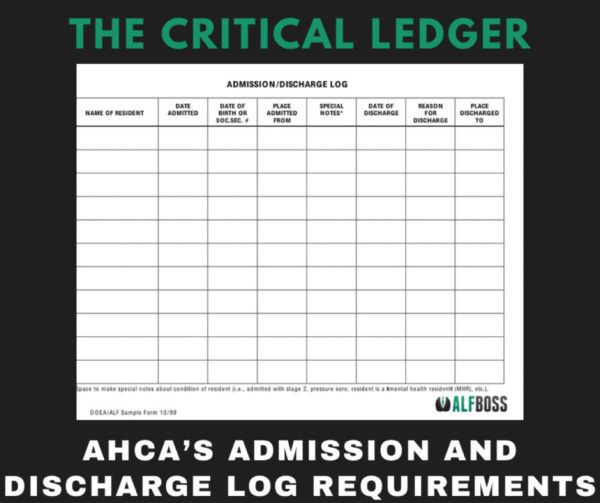
The Critical Ledger: Mastering AHCA’s Admission and Discharge Log Requirements
Assisted living facilities (ALFs) serve as essential havens of care and support for residents, ensuring their well-being through meticulous care and adherence to regulatory standards. One of the key regulations that facilities must comply with is Regulation 59A-36.015, which focuses on the maintenance of admission and discharge logs. This article explores the critical aspects of this regulation and provides practical guidance on how to master its requirements.
Understanding Regulation 59A-36.015
Maintaining an Up-to-Date Admission and Discharge Log
Regulation 59A-36.015 mandates that ALFs maintain a comprehensive and current log of all resident admissions and discharges. This log is essential for ensuring continuity of care, facilitating regulatory compliance, and providing a clear record for auditing and inspection purposes.
Key Requirements of the Admission and Discharge Log
1. Details Required for Admissions
For each resident admitted to the facility, the log must include:
Resident’s Name: The full name of the resident.
Date of Admission: The exact date when the resident was admitted to the facility.
Source of Admission: The facility or place from which the resident was admitted, providing context and background for their care needs.
Stage 2 Pressure Sore Notation: If applicable, a notation indicating that the resident was admitted with a stage 2 pressure sore. This is critical for ensuring appropriate care and monitoring from the outset.
2. Details Required for Discharges
For each resident discharged from the facility, the log must record:
Date of Discharge: The specific date when the resident left the facility.
Reason for Discharge: The reason for the resident’s discharge, whether due to health improvement, transfer to another facility, or other reasons.
Destination Upon Discharge: Identification of the facility or home address to which the resident was discharged. This ensures follow-up care and accountability.
Readmission Requirements
In cases where a resident is readmitted to the facility after being discharged, a new entry must be made in the log. This entry should reflect the fresh admission, ensuring the log remains current and accurate.
Importance of Compliance
Adhering to Regulation 59A-36.015 is not merely a matter of regulatory compliance; it is integral to providing high-quality care and ensuring the safety and well-being of residents. Proper documentation helps in tracking residents’ health status, facilitating communication among caregivers, and providing necessary information during inspections and audits.
Best Practices for Record-Keeping
To comply with this regulation effectively, ALFs should consider the following best practices:
1. Regular Updates: Ensure that the admission and discharge log is updated immediately upon any changes to maintain accuracy. Prompt updates prevent information gaps that can lead to compliance issues or lapses in care.
2. Training Staff: Train staff on the importance of accurate record-keeping and the specific details required by the regulation. Regular training sessions can help reinforce the importance of meticulous documentation and ensure that all team members are up to date with the latest requirements.
3. Use of Technology: Utilize electronic health records (EHR) systems to streamline the documentation process and reduce the risk of errors. Digital records can also facilitate easy retrieval of information during audits or inspections and support data security.
4. Periodic Audits: Conduct regular internal audits to ensure compliance with the regulation and identify any areas for improvement. These audits can help catch potential issues early and provide opportunities for continuous improvement in record-keeping practices.
5. Standardized Forms: Use standardized forms for admissions and discharges to ensure consistency in the information recorded. This can help reduce errors and make it easier for staff to know exactly what information is required.
Conclusion
Regulation 59A-36.015 underscores the critical importance of maintaining an up-to-date admission and discharge log in assisted living facilities. By diligently recording the necessary details for each resident’s admission and discharge, ALFs can enhance the quality of care, ensure regulatory compliance, and provide a robust framework for monitoring and auditing resident transitions. Facility operators should prioritize accurate and timely record-keeping as an essential component of their operational practices. The critical ledger is more than just a requirement; it is a fundamental tool for ensuring the health and safety of every resident entrusted to an ALF’s care.
